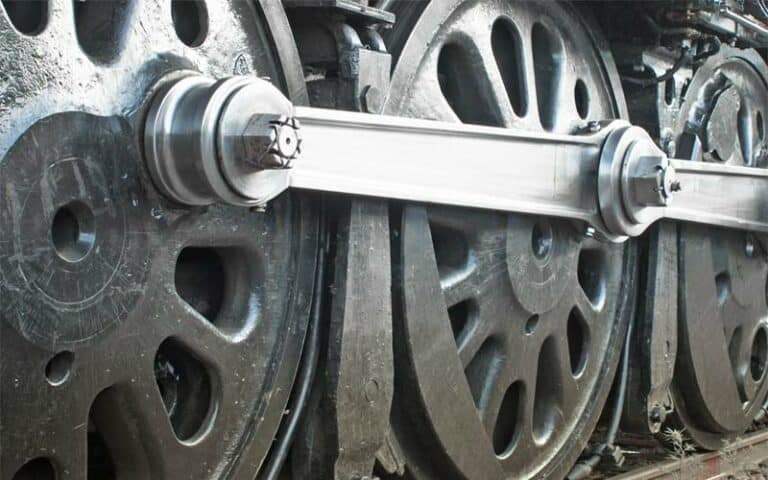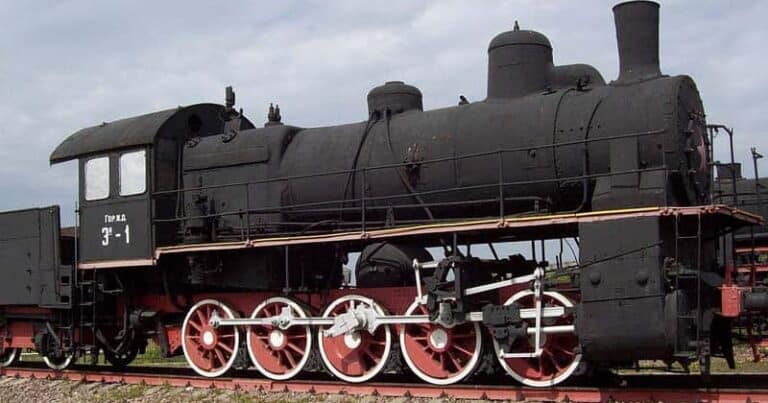Pennsylvania Railroad S1 #6100, One of a Kind
The Pennsylvania Railroad tasked its Juniata Shops in Altoona with some pretty big jobs, and some unusual jobs… like the only 6-4-4-6 steam locomotive ever built. Like some other large railroads in the steam era the PRR built some of their own steam locomotives to supplement orders placed with builders like Baldwin and Alco.
One of the most famous locomotives to be built at the PRR shops is Pennsylvania Railroad’s only member of the S1 class, #6100. It had a short but interesting life! It’s a story railfans still talk about.

Development of #6100
Although she wasn’t complete and ready for testing until 1939, planning for the #6100 can be traced back to 1936. The Pennsylvania Railroad sought to replace their K4 passenger locomotives with a new locomotives that could hit speeds of 100 miles per hour.
Early in the project, the railroad turned to Baldwin Locomotive Works to consult on the design of the new locomotive. But the railroad wasn’t happy with the results and quickly terminated the consulting agreement. Instead, the company put together a design team featuring representatives from Baldwin, Alco, and Lima Locomotive Works.
In July 1937, the railroad announced plans for the new “Pennsylvania type” steam locomotive which would offer high speed passenger service, though the design would have to be modified significantly for the final version due to weight issues. The locomotive was given a streamlined appearance designed by a famous industrial designer Raymond Loewy.

Technical Information
The coal-burning S1 locomotive featured a 6-4-4-6 wheel arrangement, though the locomotive was not articulated due to stability concerns at high speeds. Instead, the locomotive featured a long rigid base with two pairs of cylinders that each powered two pairs of drivers. Due to her size, she lovingly picked up the nickname of ‘The Big Engine’ early on and the nickname stuck.
Pennsylvania Railroad #6100 Specs
| Length | 140 feet 2.5 inches |
| Weight | 608,170 lbs. (locomotive only), 1,060,010 lbs. with full tender |
| Boiler Pressure | 300 lbs. per square inch |
| Driver Diameter | 84″ |
| Pilot Wheel Diameter | 36″ (Leading), 42″ (Trailing) |
| Tractive Effort | 76,403 lb/f (with an 85% cutoff) |

World’s Fair and Passenger Service
Completed in early 1939, PRR #6100 was chosen to represent the railroad at the 1939 World’s Fair in New York City. Due to her size, the locomotive had to take a special route via the Long Island Rail Road; and even then she had to be towed part of the way by smaller locomotives. After the difficult trip to the city, the S1 made her debut at the exhibition on March 13, 1939.
Because the exhibit space was shared by several railroad operators, and the point of the fair was the celebrate the entire railroad industry not just one railroad’s achievements, the streamlined 6-4-4-6 had her tender lettered “American Railroads” instead of the Pennsylvania Railroad. The Pennsylvania did not give up all the glory, each placard the public say did mention that the S1 Class was designed and built by the Pennsylvania Railroad.
Another PRR oddity: Pennsylvania Railroad #4483 was rebuilt with a new wheel arrangement. Today, she is one of the last ‘hippos’ remaining.
Designed to be an active, running, display, the locomotive’s boiler generated steam as if she was on the rails pulling a train and then used the steam to power the driving wheels at a speed of 60 mph on a roller platform. It must have been a sight to behold – and hear!
When the World’s Fair shut down for the seasonal hiatus in October 1939, the locomotive found herself occupied with testing for it’s named passenger service operations, including the Manhattan Limited. However, she returned to the exhibition when it reopened in April 1940 and remained there until it closed in October of the same year.

Service Career for Pennsylvania Railroad
Hoping to capitalize on her branding following the World’s Fair, #6100 resumed passenger operations in December 1940. However, her size and weight continued to plague the locomotive and she was forced to operate primarily on the 283 mile stretch of mainline between Chicago and Crestline, Ohio (near Mansfield on the way to Pittsburgh).
The locomotive was kept busy though, averaging more than 10,000 miles a month. #6100, like all locomotives, was also a vital component of the railroad’s operations during World War II.
Known for her speed, the S1 locomotive exceeded 100 miles per hour on several occasions. In fact, there have been reports that she exceeded 150 mph, which would be a world record for steam speed. Alas, that was never confirmed, and the record remains with the Mallard.

PRR Chooses T1 over S1
Executives for the Pennsylvania Railroad hoped that the S1 would be the future of steam railroading, however the company was also developing and producing the Class T1, a duplex locomotive featuring a 4-4-4-4 wheel arrangement, during the early 1940’s. Although the S1 offered significant speed and power, the locomotive’s inability to handle most curves limited her to straight routes, limiting her overall usefulness.
The design flaws were apparent enough that the company turned their attention to designing the T1 while #6100 was still under construction and ordered the first run of the shorter locomotives before the #6100 even entered revenue service.
Retirement and Legacy
After less than a decade of time in service, the S1 was retired by the Pennsylvania Railroad in 1946. The monster locomotive sat static for a couple of years while the company considered preservation options. However, financial struggles plagued the company; and in 1949, #6100 met the scrappers torch.
Although a terrible end to her story, #6100 is gone but is certainly not forgotten.






